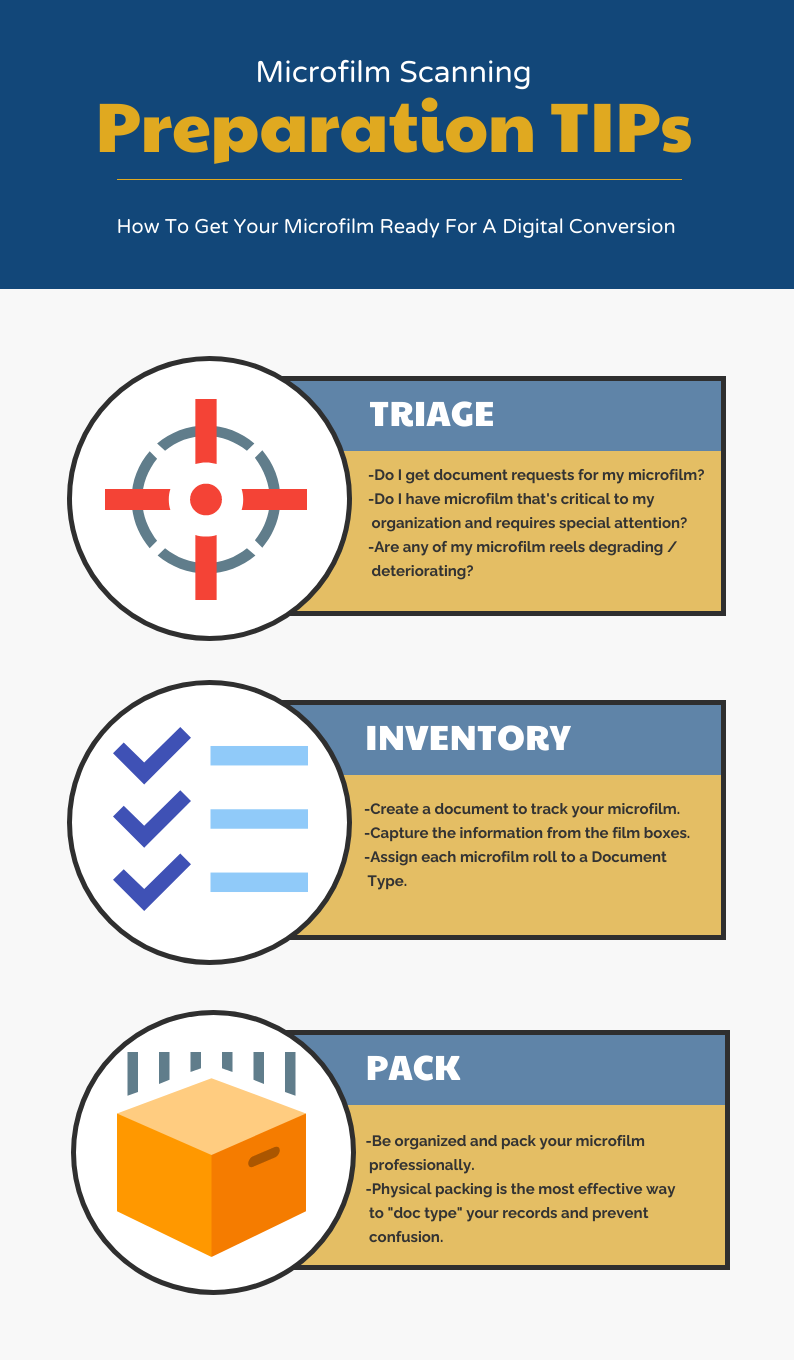If you’re about to embark on the journey of digital scanning or are just curious about the topic of preparing your microfilm for a conversion project, we’re glad you landed on our article and hope you come away with some useful information. In this article we’ll cover three topics related to preparation:
- Triage (sort) your microfilm by importance.
- Create an Inventory of your records.
- Pack your microfilm for transportation.
Each is valuable in its own right, but combined these three items can greatly help or hinder your scanning project. We’ll discuss each in detail below and recommend some action steps you can take to get your project started. An easy way to remember the three topics is to think TIPs (Triage, Inventory, Pack) as illustrated in our infographic below:

Triage Your Archive And Decide Which Microfilm Is Most Critical
Triage comes from French for to sort, and is commonly used in medical situations where the doctor has to sort patients by priority condition. We use it here, thankfully in a non-life threatening situation, because even though a microfilm conversion project can be simple and straightforward, you may have some documents that are more important than others that you want scanned first to make sure the digital content is accessible right away, or maybe scanned last because you don’t want them out of your sight for any longer than is necessary.
When you begin your microfilm triage, ask yourself the following questions:
- Do I receive requests for access to the documents on any of my microfilm?
- Do I have certain rolls of microfilm that are critical to my organization and require special attention?
- Are any of my microfilm reels degrading/deteriorating?
If the answer to any of the three questions is yes, you’ve just identified a subset of your microfilm collection! Now, find the specific microfilm and group the materials into physical batches. By doing this you’ll start to understand the scope of the triage and how it may affect your project plans, how you’ll prioritize scanning, and even how you might index/categorize your records once they’re digitized.
In addition to the three questions that can help you begin your microfilm sorting, the number of film rolls to be scanned also affects your project. If your entire collection contains around 500-1,000 reels of film, you’re likely looking at a one-batch project. With that volume, there isn’t too much reason to separate the rolls into smaller batches because most scanning companies will be able to scan them in a couple of weeks. If your collection starts getting up to the 1,500+ range then we’re more likely to recommend breaking the project up into smaller chunks so that your film isn’t just sitting around.
If you decide to work with us, each of our projects has a unique scanning process flow, the framework for executing each step of the digital conversion. The first step in the process flow is actually creating one for you! Once the process flow is set up, we run our Milestone 1 Proof of Concept test using a small sampling of your material to make sure the project will run smoothly, to ensure image quality, and to give you a chance to approve your final product before we go full steam ahead with the entire microfilm collection. When you’re sorting your film during the triage stage, you may want to select a handful of rolls that represent a good cross-section of your entire archive; this way, we’ll be able to see the good, the bad, and the ugly during testing.
Inventory Your Microfilm For Your Scanning Project
Once you’ve triaged your microfilm and sorted all the rolls into distinct batches based on your project criteria, your next step is to inventory your records. Before getting too far into this section, we do have a caveat: inventories are prone to human error and it’s rare to see an inventory that is 100% accurate. Don’t let this scare you away from creating an inventory, but it’s a heads up that data that’s physically captured before your scanning project may not match the data that’s created after your microfilm is scanned and indexed.
Creating an inventory for your microfilm prior to having it digitized gives you and your scanning partner the ability to locate records if the need arises. Why would you need to access film that’s part of a scanning project? If you work at a university registrar’s office, a former student may call and ask to see her transcripts, and since you don’t have the film in your office anymore you’d need to have the scanning company locate the film and have it scanned right away. Without an inventory or a clear way to find the film, it may be impossible to locate the film.
Follow these steps to create a simple microfilm inventory (as available or applicable):
- Start a new spreadsheet or some other document to track your records.
- Capture the information from your microfilm boxes.
- Roll Number
- Roll Title, such as “1958-1959 Abbott – Berry”
- Assign each microfilm roll to a document type.
- A “doc type” is a category to which your microfilm belongs.
- An example for court records could be the doc Types “Confidential” and “Non-Confidential,” and “Criminal” and “Civil.”
There’s a lot more you could do with an inventory, but for the purposes of this article we’re just giving you a place to start. The key is to try to capture the general information from your microfilm so you know what you have before you start the project, not necessarily to create an all-encompassing document that lays out all possible permutations of digital organization. That can come later, and you may want to read our post about indexing if you’re interested.
Pack Your Microfilm For Transportation
After conducting your triage and creating an inventory, the last step to complete is physically preparing your microfilm for transportation to your scanning partner. This part is very important. When you pack your microfilm and get it ready to be picked up by or shipped to your scanning partner, there are two things to remember:
- Be organized and pack your microfilm professionally.
- Physical packing is the most effective way to doc type your records and prevent confusion.
We’ll briefly cover each point:
What’s the most secure way to protect your microfilm during transportation?
The safety of your microfilm during transportation is a valid concern. This may be the only copy you have of the data and if it were lost, that’s it, no more documents. So how do you protect your film?
Am I Ready To Start A Project?
Take a look at the scenarios below and choose which one best relates to your situation and follow the steps to get your project moving ahead:
Scenario 1 – I’m Ready To Start My Microfilm Digital Conversion Project
- Have you decided if you want to hire a company to scan your microfilm, or do you want to do the conversion internally? If you’re not sure which scanning solution is best, we recommend you read our article about hiring a company to scan your film to become familiar with the pros and cons of outsourcing vs in-house scanning. Some examples include film scanners, storage space, project management, available technology, and level of expertise.
- If you already know you want to hire someone, maybe we’re a good fit for you. Check out the “Next Steps” section below for contact information.
Scenario 2 – I’m Not Ready To Start My Microfilm Digital Conversion Project Yet, But It’ll Happen Soon
- Good to know that you’re thinking about it now and getting ahead of the game. Read our post that discusses the timeline factors of a digital scanning project so you don’t end up rushing the process.
- If you’re able to identify an “Execution Date” (this is in the article) and want to talk about how to make your project a reality in the future, we’re happy to take your call and toss around ideas and options.
- Understand the risks of not moving forward with digital solutions and take a look at our disaster preparedness page. You’ll see the importance of having a digital disaster recovery copy of your material!
Next Steps
Reach out to us today! Click the “Get Your Quote” button below, fill out the form, and we’ll quickly reply to you to discuss your project.
Further Reading
Below are some additional articles you can read to learn more about scanning and digital conversion.
“The BMI Microfilm Scanning Process” describes the 10 steps we take to scan your microfilm. There’s an infographic included so you have an easy-to-follow visual representation of the process.
“How Much Does Microfilm Scanning Cost?” describes the 9 factors that affect your scanning price. This is a great place to start to get a ballpark idea of what you might pay if you decide to digitally convert your microfilm collection.
‘How To Choose The Right Microfilm Scanning Partner” provides you with our insights into how to select the right scanning partner for you. And yes, we might not be the right fit.

